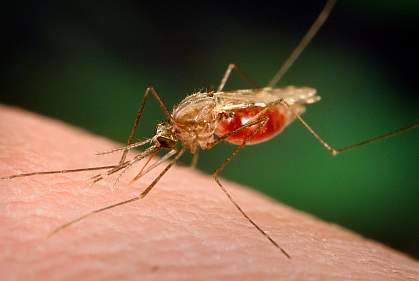Researchers led by teams at the University of California, Riverside (UCR), the University of California, Irvine, and the Yale School of Medicine have developed a compound that they found to be effective against drug-sensitive and drug-resistant strains of the malaria parasite Plasmodium falciparum in vitro and in a humanized mouse model engineered to have human blood. The synthetic compound, designated MED6-189, is inspired by natural products derived from marine sponges.
Describing their work in Science, “A kalihinol analog disrupts apicoplast function and vesicular trafficking in P. falciparum malaria”, the researchers, headed by Karine Le Roch, PhD, a professor of molecular, cell and systems biology at UCR, reported that MED6-189 blocked both asexual replication and sexual differentiation in P. falciparum, and was also effective against P. knowlesi and P. cynomolgi parasites. In their research article summary Le Roche and colleagues concluded, “Our findings establish MED6-189 as a multitarget compound with limited capacity for the parasite to develop drug resistance, providing a promising new lead in the fight against malaria.”

In 2022, most of the 619,000 estimated global deaths due to malaria were caused by Plasmodium falciparum, the most virulent, prevalent, and deadly human malaria parasite, the authors reported. For decades, the parasite’s resistance to antimalarial drugs has posed a big challenge for researchers working to stop the spread of the disease. “Because of widespread resistance to commonly used antimalarials, artemisinin-based combination therapies (ACTs) represent the last resort in the antimalarial armamentarium,” the team wrote. However, there have also been reports of emerging ACT resistance in various regions of the world. “There is therefore an urgent need to identify novel therapeutics to combat the ever-growing threat of drug resistance and to suppress the spread of the disease,” the team continued. “Ideally, such molecules should target pathways not previously targeted by approved antimalarials or those in clinical development.”
MED6-189 is a synthetic analog of the kalihinol family of isocyanoterpene natural products derived from marine sponges that had previously been found to exhibit potent activity against drug-sensitive and drug-resistant P. falciparum isolates, the investigators noted.
For their newly reported study MED6-189 was synthesized in the lab of Christopher Vanderwal, a professor of chemistry and pharmaceutical sciences at UC Irvine. The team developed a system for scaling up synthesis to support in depth mechanism of action studies and allow them to investigate toxicology and in vivo efficacy.
Their study findings showed that MED6-189 disrupts apicoplast biology, slows growth, and kills the parasite, the team noted in their research article summary. The apicoplast is an organelle essential for the synthesis of parasite fatty acids and isoprenoids, they explained. “Transcriptomic, metabolomic, and proteomic experiments indicated that the compound interferes not only with lipid metabolism but also with vesicular trafficking,” the team continued.
The investigators suggest that MED6-189’s dual mode of action—targeting the apicoplast and disrupting vesicular trafficking pathways—prevents the pathogen from developing resistance, indicating that the drug could be a promising new lead in the fight against malaria.
Vanderwal added, “Many of the best antimalarial agents are natural products, or are derived from them. For example, artemisinin, initially isolated from the sweet wormwood plant, and analogues thereof, are critically important for treatment of malaria. MED6-189 is a close relative of a different class of natural products, called isocyanoterpenes, that seem to target multiple pathways in P. falciparum. That is beneficial because had only one pathway been targeted, the parasite could develop resistance to the compound more quickly.”
For their in vivo tests, researchers at GSK in Spain administered MED6-189 to the mice infected with P. falciparum, showing that it cleared the mice of the parasite. In collaboration with Choukri Ben Mamoun, PhD, a professor of medicine and microbial pathogenesis at the Yale School of Medicine, the team also tested the compound against P. knowlesi, a parasite that infects monkeys, and found it cleared the monkey’s parasite-infected red blood cells. Reporting on their studies, the team stated, that MED6-189 inhibited both drug-sensitive and drug-resistant P. falciparum strains. “Phenotypic assays showed that this compound blocked parasite sexual differentiation, had a promising tolerability profile against human cells, and cleared P. falciparum infection in a humanized mouse model,” they wrote. “The compound also exhibited potent activity against P. knowlesi and P. cynomolgi.
Le Roch added, “Disruption of the apicoplast and vesicular trafficking blocks the parasite’s development and thus eliminates infection in red blood cells and in our humanized mouse model of P. falciparum malaria. We found MED6-189 was also potent against other zoonotic Plasmodium parasites, such as P. knowlesi and P. cynomolgi.”
Next, the team plans to continue the optimization of MED6-189 and further confirm the modified compound’s mechanisms of action using a systems biology approach, which offers researchers a way to examine how different living organisms and cells interact at larger scales.
“Overall, our results show that MED6-189 has an efficient and sophisticated mode of action to which it has proven challenging for the pathogen to develop resistance,” the authors stated. “These combined characteristics make MED6-189 an optimal candidate for use in combination with fast-acting compounds or as a preventative, with reduced susceptibility for emergence of drug resistance.”


